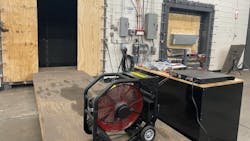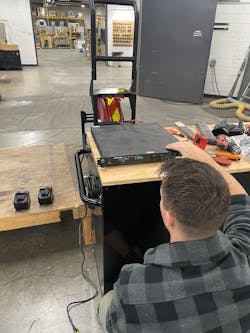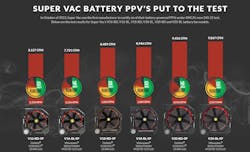New AMCA Standard Helps Firefighter Choose Battery-Powered Fans
With the evolution of battery-powered fans for building fire ventilation becoming the norm on the fireground today, an effort has been made to ensure the fans are clearing the hazardous environment efficiently.
The Air Movement Control Association (AMCA) has long been acknowledged as a leading expert in airflow development and measurement. The AMCA Standard 240 was designed to assess and evaluate the effective airflow of a positive pressure ventilator (PPV) installed in a conventional entryway. This test was updated in 2022 to particularly evaluate battery-powered PPV fans, and it was developed in consultation with industry experts, firefighters, and PPV manufacturers.
“The main mission for AMCA is to create a level playing field,” said AMCA’s Global Technical Director, Nazme Mohsina. “Each and every manufacturer must follow the same rule. Whenever you buy a PPV, you can compare apples to apples.”
The first company to achieve the new AMCA 240-22 Standard rating was Fort Collins, CO-based Super Vac. The growing popularity of battery-powered fans forced some hands to continue to develop a standard to meet international needs, keep firefighters safer, and produce a more efficient system.
“There was a version of the standard in 2016 that existed, but the test became dated when battery fans started to become more popular in the positive pressure ventilation market," said Amy Speer, marketing director for Super Vac.
AMCA 240-22 was officially announced in April of 2024 as the revisions from the original standard, 240-16, began two years ago. There were three new variables in the upgraded standard compared to identical fans to provide more accurate runtimes and resulting in lower airflows.
“The earlier standard didn’t account for a number of variables that battery fans have since introduced. These variables greatly affect the reported airflow data,” Speer told Firehouse.com. “We had identical fans that were measured in 2016 to this new standard, and the outputs changed because of these variations.”
Both AMCA and Super Vac wanted to be able to create numbers that can be trusted in the fire service. AMCA performs check tests every three years.
Those three variables and the changes were:
- A smaller doorway: To meet international standards, AMCA adjusted the doorway dimensions from 6' 8" x 3' (2.03mX0.91m) to 6' 3" x 3' 2" (1.90mX0.97m).
- Constant Power Supply: Since battery power drops over time, AMCA connects the PPV to a constant voltage DC power supply to ensure other variables will not effect test results.
- Documentation of Runtimes: The PPV is run at full speed until its two full charged batteries run out of power to ensure runtime accuracy across all manufacturers.
“A battery’s charge is variable and decreases over time, so AMCA didn’t want the drop in battery power to effect the certified airflow, which is why a constant power supply was introduced during the test.”
During testing, AMCA opted to connect the fan to a constant voltage DC power supply for more consistent results.
"It's not measuring what the battery is doing. We're measuring what the span itself can do when it's at its best battery power," added Speer.
The numbers above in the graphic resulted from a maximum output rating tested at 15-foot setback, with the fan tilted at a 10-degree angle for Super Vac fans.
On a similar wavelength, Speer concedes that there are a lot of fire industry standards that come with asterisk, which can make it hard for firefighters to trust the data. Third-party standards ensure specifications can be trusted, Speer said.
The 240 standard varies from other standards because it considers entrained air. As entrained air is the air that goes through the doorway not directed from the fan. Entrained air can multiply the total airflow by 1.5 to 2 times. Airflow plays an important role in ventilation duration because it is generally accepted that 10 airflow changes are required to properly ventilate most rooms.
The new standard was voted on by four different members a part of the committee, along with five non-voting members. Super Vac is the only one to meet the latest standard, according to AMCA.
These standards get revised in various ways. One being posting your comment to AMCA directly. Each division cycle, they look at reviews and comments on each product seeing what challenges have been faced with that new product.
Overall, AMCA has been working diligently to combine safety, efficiency, battery-powered fans with PPV’s to curate a better environment when trying to ventilate a room.

Ryan Baker
Ryan Baker is a writer and associate editor with prior experiences in online and print production. Ryan is an associate editor for T&D World and Firehouse, while he is going to graduate school in pursuit of a master's degree in sciences of communication at University of Wisconsin-Whitewater. He recently completed a year of teaching Intro to Public Speaking at UW-Whitewater, as part of his graduate program. Ryan acquired his bachelor's degree in journalism in 2023 from UW-Whitewater, and operates currently out of Minneapolis, MN. Baker, also writes freelances for the Ultimate Frisbee Association (UFA) in his free time, while also umpiring baseball for various ages across the Twin Cities Metro Area.









